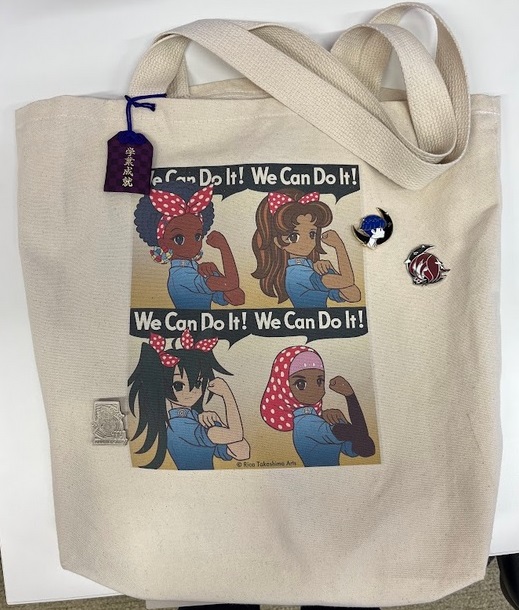
It’s Friday, 12:15pm, and I’m tiptoeing in a bathroom stall, cautiously stepping on my shoes, one at a time, avoiding the floor as if it were lava, getting changed into my Kyouko Sakura (Madoka Magica) cosplay, preparing to attend Erica’s first panel at AnimeNYC. I’m 35 years old and I’ve never cosplayed in my whole life. It’s my third time at AnimeNYC, and every year I told myself that I would dress up as my favorite character, Kyouko. But for some reason, I always found excuses not to do it, and always regretted it. Each flight back to Argentina, I promised myself that next year I would, for sure.
That’s why the excitement of getting into my stockings, my skirt, and my frilly dress is so overpowering that I forget what this bathroom stall has seen before me and what it will endure with its next occupant. I come out, and the only thing left is the final touch: the cute bow.
The transformation sequence is complete. I am now a Magical Girl.
Hello, world!

“The Rise of Queer Manga” was an amazing panel about how Yuri and BL evolved into queer narratives that explore LGBTQ+ representation, both through memoir and fictional writing. The panel was great not only because of the diverse voices and perspectives with a strong presence in the industry, but also because the panelists were fans themselves, and it showed in the way they spoke. When a panelist’s voice breaks while speaking about something that’s important to them, you know it’s rooted in deep love for the works being covered. It’s heartwarming to see folks who resonate with the medium in the same way that I do. On top of being informative and emotive, it was genuinely fun. The crowd had a great time; we all laughed with the four panelists gushing over their recommendations, and, of course, we cheered each time we heard our favorite mangas mentioned.
Works that I want to check out after attending this panel: Just Like Mona Lisa (Tsumuji Yoshimura), Boys Run the Riot (Keito Gaku), Until I Meet My Husband (Ryousuke Nanasaki).

After that great start, I saw the immensity of this year’s convention; the Javits Center was packed even though it was a Friday. Aside from the date, there were some other changes from last year. Everything was bigger, and there was more of it, but at the same time, it didn’t feel as exciting. Speaking for myself, there weren’t many international guests that I was eager to see, except for Chiwa Saito, but, of course, I didn’t win the lottery for her signing session. I also found the layout of the booths and tables harder to understand; I got lost quite often when trying to backtrack to a shop that had something I liked, which, more often than not, was somewhat on the expensive side.
Another thing that surprised me was the lack of variety in terms of shows and merch. It seemed like everyone played it safe and only carried items from classic shows (Evangelion, Sailor Moon, Madoka, etc.), ultra-popular shows (Jujutsu Kaisen, Chainsaw Man, etc.), popular video games (Honkai Star Rail, Genshin, etc.), and trendy or seasonal anime (Frieren, Demon Slayer, etc.). I love some of those series, but I was looking for merchandise from more niche series, and I didn’t find it.
Unsurprisingly, a lot of the Frieren merch was very shippy, and that bothered me. Himmel was everywhere, as if the only reason for Frieren to exist was to pair her, the strongest sorcerer of all time, with him, the blue-eyed hero. It was honestly disappointing to see that a significant focus surrounding the series was disconnected from what makes the show beautiful to me. There wasn’t even Flamme, Eisen or Heiter merchandise, mainly Frieren, Himmel, Fern, and Stark. That merch doesn’t pass the Bechdel Test, I swear. I have to admit that if I had found anything with Kanne and Lawine, I would have bought it though… Oh, well.
One of my highlights was meeting Erica, Sean Gaffney, and Rica Takashima at Erica’s table. It was great seeing a very brief history of Yuri on the wall, with the ships we had discussed on Discord. It was fun to see how our online chats led to real-life connections. We shared a few Alfajores and Conitos de Dulce de Leche that I brought from Argentina, we discussed academic topics, I received tons of recommendations, and bought a beautiful tote bag with Rica’s art.
Erica won’t tell you, but as early as the start of Day 2, she sold out every last book she brought to the convention. (Erica here: Oh yes, I will absolutely tell people! ^_^ Buy my book! Buy my book!!)
While I was at the Yen Press booth and checking out the preview of The Guy She Was Interested In Wasn’t a Guy at All, I started chatting with someone who was also looking at the book. As it turns out, she had bought By Your Side and a few Yuri prints!

When the bells announced 7 pm, I tried to go to the cosplay changing rooms before my carriage turned into a pumpkin, but they were already closed, so I had to wait for a bathroom stall to clear up to change back into my everyday clothes. Again the tiptoeing, again the dance around the shoes, again the regret of having to change to take the train.
But… why?
That’s the question that I kept asking myself during the ride back to Brooklyn.
And that’s how I realized that I wanted to fight against that fear, and why, the next day, I got changed in my room and went out on the street with my costume on. The feeling was incredibly liberating.
While I was sitting on the train, a lady came and told me that she loved my outfit; it felt so nice ❀. That was just the start of it, because during that day and the next, two more people on the street (non-con-goers) complimented the cosplay!
I love checking the artist alley, so I spent a lot of time walking there and examining every table, but after three days, I said goodbye to my dream of getting a Sweet Blue Flowers t-shirt, charm, keychain, enamel pin, or whatever I could get my hands on. I did get to meet Pemprika again, and we chatted a lot about Houseki no Kuni, Madoka, and Utena. I also left all my earthly possessions at her store because her art is beautiful.

I never take pictures of myself because I just don’t know what to do; I feel self-conscious and awkward. But, by being Kyouko, I had a few people come to me and ask for pictures of my cosplay. I was anxious but excited at the same time, and even though the first few ones were probably not great, I felt more at ease with each photo. I even ended up taking a picture with someone who was cosplaying Aya from The Guy She Was Interested In…
On Saturday, I attended the “Category Is: Magical Person Realness” panel, which explored queerness and queer coding within the Magical Girl genre. I found myself sobbing a lot with the fragments presented and laughing a lot with the commentaries. To wrap up the panel, there was a very fun fan-voting session to determine the definitive Magical Girl ship, in which Madoka and Homura won against Haruka and Michiru in a very tight final. I was pleasantly surprised that Cocona and Papika made it very far in the brackets.
Works to check out after attending this panel: Witch Hat Atelier, Kill la Kill.
On Sunday, I attended the other panel where Erica was participating; this time it was “A History of Manga by Decade: Manga’s History Two Books at a Time,” where Zack Davisson and Erica did a great job immersing the audience in a trip through Japan’s modern history told through comics. I loved this panel so much that I wished it lasted another hour or, at least, included a few more books per decade because it was incredibly rich, and Zack and Erica made a really entertaining and thought-provoking team.
From this panel, I need to check out more information on Shigeru Mizuki, Yokohama Kaidashi Kikou (Hitoshi Ashinano), and Our Dreams at Dusk (Yuhki Kamatani).

After that, I wandered around taking pictures of cosplayers, checking out booths I had missed, and realizing that post-con depression had set in earlier than expected.
As people flooded out of our glass castle into the streets of New York, I made my way back to the subway.
And there, suddenly, in the reflection of a train platform timetable, I found myself: that 12 13-year-old in love with Asuka and wanting to be her at the same time. Projecting myself as the character who had to act tough because that’s what she thought society demanded, constantly looking for validation from others rather than loving herself.
My younger self, entangled in video games, always picking the heroine, always identifying with the princess, always longing to be them.
The make-do mirror returned the image of a strong, proud, magical girl, a few directions on how to get to Brooklyn, and an arriving train schedule.
Erica here once again: Thank you Matias! It was amazing meeting you…and I am still enjoying the sweets you brought. ^_^
For those of you wondering where my report is…well Sean Gaffney and I did a very rich review of the American Manga Awards that should post soon on Anime Herald…and I have a special treat from Yen Press coming up (!), so check back for that! ^_^ It was an amazing event, as usual. I hope to return again soon.
![]() by Sandy Ferguson, Guest Reviewer
by Sandy Ferguson, Guest Reviewer

